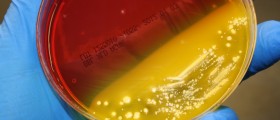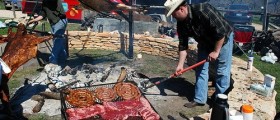
At first, Escherichia coli was considered to be nothing more than a commensal organism of the large intestine. It was described for the first time in the year 1885 by Theodor Escherich as Bacterium coli commune. Escherich found the bacterium in the feces of newborns and isolated it. However, until 1935 no one knew that the strain of E. coli can be blamed for the onset of diarrhea among infants. This was proved in 1935.
Infection of the Bowel
E. coli does not only live in the digestive tract of humans. It inhabits the gastrointestinal tract of animals as well. This bacterium does not have only one type but quite a few of them. The good thing is that the majority of E. coli strains do not cause any harm. However, there are some which can lead to bloody diarrhea and they are named enterohemorrhagic E. coli or EHEC. One type of the bacterium is relatively common and is known under the name E. coli O157:H7. This particular bacterium is especially dangerous because not only it can lead to bloody diarrhea but it can also cause certain other health problems like severe anemia or kidney failure. Both of the mentioned health issues can be fatal. Also, the bacterium may trigger various other infections and infection of the urinary tract is only one of them.
The infection caused by E.coli mostly occurs once an individual gets in contact with feces of either humans or animals. The bacteria are introduced into the body via consuming food or water contaminated with feces.
For instance, the bacteria can contaminate meat during processing. The meat needs to be cooked to 160 degrees F or the bacteria will not die. When the person consumes such meat, the bacteria enters the body and precipitates infection. Undercooked meat is the number one cause of E. coli infection in the United States.
Other foods can also get infected with the bacteria by simply getting in contact with the infected meat. Raw milk and dairy products may be contaminated with the bacterium as well. This is one of the reasons why it is better to purchase milk and other dairy products which have a “pasteurized” label on them. This label confirms that the product was heated and that practically all the bacteria have been killed. Furthermore, raw fruit and vegetables can get infected with E. coli too. As a matter of fact lettuce and alfalfa sprouts are two vegetables which are most likely to get in contact with animal feces and get contaminated with the bacterium. All in all, practically all food may be suitable for further bacterial multiplication if it gets in contact with E.coli and is not thermally processed before consumption.
Both human and animal feces containing E. coli can end up in lakes, pools and even water supplies and infect people who drink the contaminated water or use it for food preparation. Even accidental swallowing of water that has E. coli in it may trigger the infection.
E. coli can under certain circumstances infect a person in case he or she is in contact with a person who is already infected. This usually happens due to not washing the hands after bowel movement.
Symptoms of E. coli infection are stomach cramps, nausea and vomiting as well as bloody diarrhea. The first problems will usually appear a couple of days after getting infected. Most often a person feels better after a week or so but if this does not happen, going to the doctor is a must. If the bacterium has already caused damage to the kidneys, there are additional health issues such as pale skin, fever, weakness, bruising and passing small amounts of urine.
Characteristics of Escherichia Coli
Enterobacteriaceae is the name of a large bacterial family and E. coli is the head of it. All of the bacteria from this family live in the intestinal tract of humans and animals.
E. coli is considered to be quite versatile and easily adaptable to its habitat. The bacterium does not need O2 in order to grow. It can grow by means of fermentation. Apart from this, E. coli can grow by means of anaerobic respiration as well.
Since E. coli is a unicellular organism, it will respond to various signals from the environment like chemicals, temperature and pH, among others. E. coli can sense the presence or absence of chemicals and swim either towards or away from them. The bacterium may survive freezing temperatures but it is easily killed by cooking or pasteurization.
The total bacterial content in the human intestinal tract shows that E. coli makes a really small portion of it. E. coli is less present in the intestines compared to the anaerobic Bacteroides species ( the ratio 20:1).
And finally, E. coli is generally of low infective dose i.e. only 10-100 cells may be sufficient in a portion of food to trigger infection.

















Your thoughts on this
Loading...